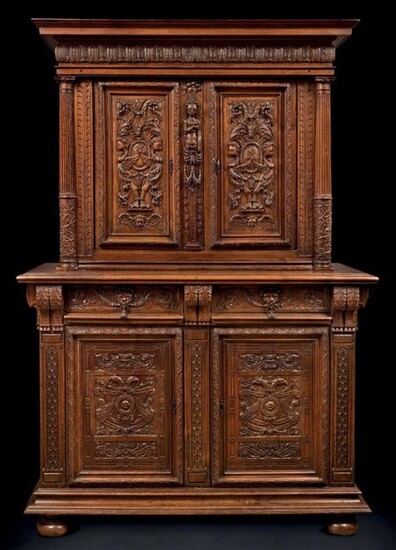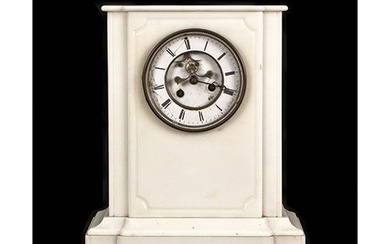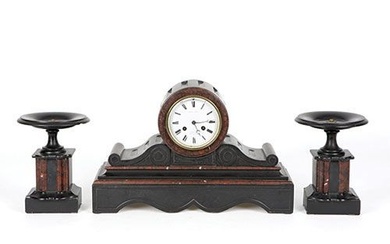FRANCE SECONDE MOITIÉ DU XVIe siècle
FRANCE SECONDE MOITIÉ DU XVIe siècle
BEAUTIFUL TWO-BODY CABINET Burgundy or Lyon, circa 1560-1580 Light
walnut
H. 187 cm, W. 130.5 cm, D. 52 cm
Very good condition
Bibliography
Jacques Thirion, Le mobilier du Moyen-Âge et de la Renaissance en France, Ed. Faton,
Paris, 1998
The second half of the sixteenth century delivered prestigious models of cupboards, built according to a new architectural design; two superimposed bodies, the recessed top simply placed on the low cupboard, four mitre-jointed panels, a row of middle drawers. The order of the decoration is totally in keeping with the architecture: sculpted friezes on the entablatures and terms on the uprights and frames. The use of walnut is becoming widespread, a source of great refinement in the decoration and a more "smooth" patina (J. Thirion).
This piece of furniture has all the characteristics of the Second French Renaissance.
The latter is indeed characterized by an architectural conception of furniture resulting from the rediscovery of ancient architecture through the reading of certain architectural treatises such as those of Vitruvius, Serlio, Philibert Delorme or Jacques
Androuet du Cerceau.
The ornamental vocabulary illustrates a return to the ancient world with an abundant use of palmettes, acanthus, volutes, or eagles. This antiquarian repertoire first appeared in France on royal building sites, notably
Fontainebleau, through the Italian artists who worked there, following the example of Rosso or Primatice. These artists completed their compositions with astonishing figures, such as chimeras and harpies, mascarons, garlands of fruit and flowers and cut leather.
These ornaments, new in French art, benefit from the development of engraving which allows a very wide diffusion. From then on, many illustrated books and collections of ornaments and emblems accompanied the work of huchiers and image tailors who reinterpreted them in order to adapt them to the furniture they made.
In the 16th century, furniture was no longer considered only from a practical point of view but became an essential part of the decor. It is therefore adorned with a formidable sculpted decoration. The combined influences of the Burgundian and Lyon schools are found in this two-part piece of furniture. In the first one, it borrows the vivacity of the sculpted decoration.
The great architectural perfection, the style of the cartouches, organized around a central element, the interlacing and the decoration borrowed from the engraver's art relate to the skill of the huchiers and sculptors of the second. Automatically translated by DeepL. To see the original version, click here.
View it on
Estimate
Time, Location
Auction House
FRANCE SECONDE MOITIÉ DU XVIe siècle
BEAUTIFUL TWO-BODY CABINET Burgundy or Lyon, circa 1560-1580 Light
walnut
H. 187 cm, W. 130.5 cm, D. 52 cm
Very good condition
Bibliography
Jacques Thirion, Le mobilier du Moyen-Âge et de la Renaissance en France, Ed. Faton,
Paris, 1998
The second half of the sixteenth century delivered prestigious models of cupboards, built according to a new architectural design; two superimposed bodies, the recessed top simply placed on the low cupboard, four mitre-jointed panels, a row of middle drawers. The order of the decoration is totally in keeping with the architecture: sculpted friezes on the entablatures and terms on the uprights and frames. The use of walnut is becoming widespread, a source of great refinement in the decoration and a more "smooth" patina (J. Thirion).
This piece of furniture has all the characteristics of the Second French Renaissance.
The latter is indeed characterized by an architectural conception of furniture resulting from the rediscovery of ancient architecture through the reading of certain architectural treatises such as those of Vitruvius, Serlio, Philibert Delorme or Jacques
Androuet du Cerceau.
The ornamental vocabulary illustrates a return to the ancient world with an abundant use of palmettes, acanthus, volutes, or eagles. This antiquarian repertoire first appeared in France on royal building sites, notably
Fontainebleau, through the Italian artists who worked there, following the example of Rosso or Primatice. These artists completed their compositions with astonishing figures, such as chimeras and harpies, mascarons, garlands of fruit and flowers and cut leather.
These ornaments, new in French art, benefit from the development of engraving which allows a very wide diffusion. From then on, many illustrated books and collections of ornaments and emblems accompanied the work of huchiers and image tailors who reinterpreted them in order to adapt them to the furniture they made.
In the 16th century, furniture was no longer considered only from a practical point of view but became an essential part of the decor. It is therefore adorned with a formidable sculpted decoration. The combined influences of the Burgundian and Lyon schools are found in this two-part piece of furniture. In the first one, it borrows the vivacity of the sculpted decoration.
The great architectural perfection, the style of the cartouches, organized around a central element, the interlacing and the decoration borrowed from the engraver's art relate to the skill of the huchiers and sculptors of the second. Automatically translated by DeepL. To see the original version, click here.







